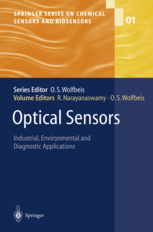Optical Sensors

The development and applications of optical chemical sensors and biosensors over the past two decades have been pursued with great interest by many researchers and have shown a tremendous growth and potential in employing such devices in many fields of application. These sensors require an interdisciplinary approach in that many scientific fields including spectroscopy, fibre optics and waveguides, optoelectronics, analytical chemistry and biochemistry, medicine and material science. The use of fibre optics and waveguides in sensors for advanced instrumentation is now well established and many novel integrated sensing systems, such as biochips, are now being developed.
In an attempt to disseminate the growth in optical sensors for many application areas such as industrial, environmental and medical diagnostics, several authors have been involved in producing this state-of-the-art type of monograph. This is the first book that is being published in a series on topics related to chemical sensors and biosensors by Springer-Verlag. The selection of topics and contributing authors for this first book on Optical Sensors have stemmed out of some of the excellent contributions made at the scientific sessions of the Europt(r)ode VI Conference that was held in April 2002 in Manchester, United Kingdom.
This book summarises various types of developments in optical sensor technology over the past two decades with an insight to future trends in this ever growing field. Chapter 1 reviews advances in this area using indicator probes and labels with a discussion of the factors that has lead to the growth of optical sensors. Chapters 2 and 3 reviews molecular recognition systems based on molecular imprints and new indicator dyes for sensing gaseous and dissolved analytes in the environment. Chapters 4 to 7 deal with aspects of optical biosensors and biochips for use in medical diagnostics and food analysis, while Chapters 8 to 15 discuss chemical transduction principles and optical sensor designs for monitoring analytes in industrial and environmental samples. These chapters illustrate a variety of transducer designs that have been investigated to date which include devices based on surface plasmon resonance, piezo-optic effects, integrated systems such as biochips, interferometric and array biosensors, and Preface
VIII Preface
involve analytical systems based on sensors with cross sensitivities and a biomimetic approach. Aspects of miniaturisation and automation are also discussed in some chapters as required, thus providing information on a truly integrated approach for analytical measurements. Thus the topics presented in this book are wide ranging and somewhat diverse but all contributions focus on diagnostics type of analytical systems.
This book is aimed at graduate students and researchers in academia and industry to provide knowledge on a group of devices based on a variety of optical detection techniques that are of novel trend in current measurements employed in analytical sciences. The authors, chosen from a list of multidisciplinary international team of researchers, are experts in their fields and are authoritative in respect of their contributions. The editors would like to express their sincere appreciation and gratitude to all authors for their efforts in preparing excellent contributions as chapters for this book with a common but diverse focus on the optical systems employed for environmental, industrial and medical diagnostic applications.
Click here for further information